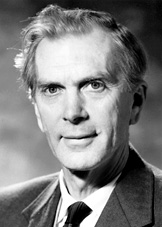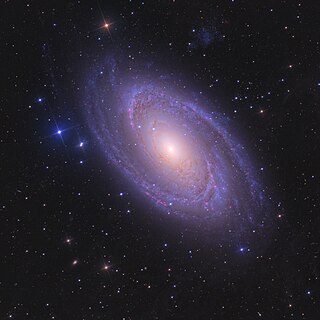
Radio astronomy is a subfield of astronomy that studies celestial objects at radio frequencies. The first detection of radio waves from an astronomical object was in 1932, when Karl Jansky at Bell Telephone Laboratories observed radiation coming from the Milky Way. Subsequent observations have identified a number of different sources of radio emission. These include stars and galaxies, as well as entirely new classes of objects, such as radio galaxies, quasars, pulsars, and masers. The discovery of the cosmic microwave background radiation, regarded as evidence for the Big Bang theory, was made through radio astronomy.
Aperture synthesis or synthesis imaging is a type of interferometry that mixes signals from a collection of telescopes to produce images having the same angular resolution as an instrument the size of the entire collection. At each separation and orientation, the lobe-pattern of the interferometer produces an output which is one component of the Fourier transform of the spatial distribution of the brightness of the observed object. The image of the source is produced from these measurements. Astronomical interferometers are commonly used for high-resolution optical, infrared, submillimetre and radio astronomy observations.

Messier 84 or M84, also known as NGC 4374, is an elliptical or lenticular galaxy in the constellation Virgo. Charles Messier discovered Messier 84 on 18 March 1781 in a systematic search for "nebulous objects" in the night sky. The object is the 84th in the Messier Catalogue. M84 is situated in the heavily populated inner core of the Virgo Cluster of galaxies.
The Third Cambridge Catalogue of Radio Sources (3C) is an astronomical catalogue of celestial radio sources detected originally at 159 MHz, and subsequently at 178 MHz.
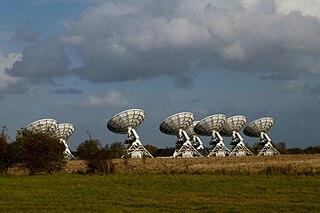
The Arcminute Microkelvin Imager (AMI) consists of a pair of interferometric radio telescopes - the Small and Large Arrays - located at the Mullard Radio Astronomy Observatory near Cambridge. AMI was designed, built and is operated by the Cavendish Astrophysics Group. AMI was designed, primarily, for the study of galaxy clusters by observing secondary anisotropies in the cosmic microwave background (CMB) arising from the Sunyaev–Zel'dovich (SZ) effect. Both arrays are used to observe radiation with frequencies between 12 and 18 GHz, and have very similar system designs. The telescopes are used to observe both previously known galaxy clusters, in an attempt to determine, for example, their masses and temperatures, and to carry out surveys, in order to locate previously undiscovered clusters.
The Cavendish Astrophysics Group is based at the Cavendish Laboratory at the University of Cambridge. The group operates all of the telescopes at the Mullard Radio Astronomy Observatory except for the 32m MERLIN telescope, which is operated by Jodrell Bank.

The One-Mile Telescope at the Mullard Radio Astronomy Observatory (MRAO), Cambridge, UK is an array of radio telescopes designed to perform aperture synthesis interferometry.
The 9C survey at 15 GHz (9C) is an astronomical catalogue generated from the radio observations of the Ninth Cambridge survey at 15 GHz. It was published in 2003 by the Cavendish Astrophysics Group of the University of Cambridge. The catalogue was originally made in order to locate radio sources which were interfering with observations using the Very Small Array, but the catalogue has also proved useful for other astronomical programs.
The Cambridge Interferometer was a radio telescope interferometer built by Martin Ryle and Antony Hewish in the early 1950s to the west of Cambridge. The interferometer consisted of an array of 4 fixed elements to survey the sky. It produced the two Cambridge catalogues of radio sources, discovering some of the most interesting astronomical objects known. The telescope was operated by the Radio Astronomy Group of Cambridge University.
The Second Cambridge Catalogue of Radio Sources (2C) was published in 1955 by John R Shakeshaft and colleagues. It comprised a list of 1936 sources between declinations -38 and +83, giving their right ascension, declination, both in 1950.0 coordinates, and flux density. The observations were made with the Cambridge Interferometer, at 81.5 MHz.

Alpha Cancri, also named Acubens, is a star system in the constellation of Cancer.

In radio astronomy, a fast radio burst (FRB) is a transient radio pulse of length ranging from a fraction of a millisecond to a few milliseconds, caused by some high-energy astrophysical process not yet identified. While extremely energetic at their source, the strength of the signal reaching Earth has been described as 1,000 times less than from a mobile phone on the Moon. The first FRB was discovered by Duncan Lorimer and his student David Narkevic in 2007 when they were looking through archival pulsar survey data, and it is therefore commonly referred to as the Lorimer Burst. Several FRBs have since been found, including two repeating FRBs. Although the exact origin and cause is uncertain, they are almost definitely extragalactic. When the FRBs are polarized, it indicates that they are emitted from a source contained within an extremely powerful magnetic field. The origin of the FRBs has yet to be identified; proposals for their origin range from a rapidly rotating neutron star and a black hole, to extraterrestrial intelligence.
The Corona Borealis Supercluster is a supercluster located in the constellation Corona Borealis and the most prominent example of its kind in the Northern Celestial Hemisphere. Dense and compact compared with other superclusters, its mass has been calculated to lie somewhere between 0.6 and 12 × 1016 solar masses (M⊙). It contains the galaxy clusters Abell 2056, Abell 2061, Abell 2065 (the most massive galaxy cluster within the supercluster), Abell 2067, Abell 2079, Abell 2089, and Abell 2092. Of these, Abell 2056, 2061, 2065, 2067 and A2089 are gravitationally bound and in the process of collapsing to form a massive cluster. This entity has an estimated mass of around 1 × 1016 M⊙. If there is inter-cluster mass present, then Abell 2092 may also be involved. It has been estimated to be 100 megaparsecs (330 million light-years) wide and 40 megaparsecs (130 million light years) deep. It has a redshift of 0.07, which is equivalent to a distance of around 265.5 megaparsecs (964 million light-years).
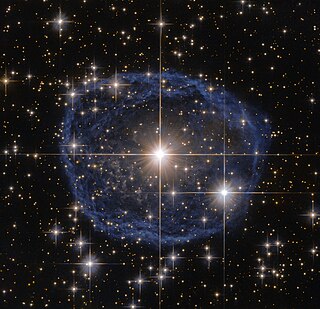
WR 31a, commonly referred to as Hen 3-519, is a Wolf–Rayet (WR) star in the southern constellation of Carina that is surrounded by an expanding Wolf–Rayet nebula. It is not a classical old stripped-envelope WR star, but a young massive star which still has some hydrogen left in its atmosphere.

R85 is a luminous blue variable located in the LH-41 OB association in the Large Magellanic Cloud.
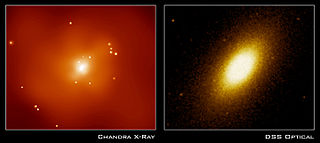
NGC 720 is an elliptical galaxy located in the constellation Cetus. It is located at a distance of circa 80 million light years from Earth, which, given its apparent dimensions, means that NGC 720 is about 110,000 light years across. It was discovered by William Herschel on October 3, 1785. The galaxy is included in the Herschel 400 Catalogue. It lies about three and a half degrees south and slightly east from zeta Ceti.


